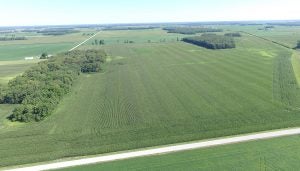A lot of the talk about drones in agriculture covers mapping fields with various types of imagery. Stitching together maps consisting of hundreds of individual pictures is a great tool for farmers, but the average drone with an average price can also be useful for just taking a quick look at large areas. Or specific perennial problem areas. Getting up above the crop canopy offers a better view than windshield scouting passing by in a pickup. This is especially true late in the season as crops get taller.
We have about 250 acres in four fields we rent. These fields have really variable soil. Anything from very sandy ridges and hills to low ground that can be quite wet. We have had a lot of rain in 2017, which is good for the sand ground because it doesn’t hold moisture long. But there are low spots that can be damaged by standing water. The largest of these spots is roughly in the middle of a 120-acre field. It covers a few acres, and it did drown out early this spring. We replanted it a few weeks after the initial planting. Mid-season we are still getting more than our fair share of rain, so I wanted to see if this low area of replant was still growing or if it drowned out again. This area is long from being able to be seen from the road. The corn is at full height, so the outside row is about all that can be seen from the road.
Instead of walking halfway through the corn I can just pop my drone up in the air, and fly out to the wet spot in a couple of minutes to see what is going on. No need for detailed mapping on a job like this. I just want to see whether there is corn growing there. Lucky for us the replant corn is just about as far along as the rest of the field. The tassels are just about to come out, and it’s just as tall and even as the higher ground all around it. While my eye in the sky was up I took it for a quick spin around the three adjacent fields to see how their low or sandy areas were doing. The sand hills are probably as good as they’ve ever been with all the rain, but I can tell by their color they are beginning to be outpaced by the good dirt.

Setting up my DJI Phantom 3, taking a quick look at the corn, and putting the drone back in the box took about 10 minutes. There’s no way I’m going to get that good of a look at those fields by walking. A general rule of thumb when scouting is to walk to five areas of the field. That’s no easy task in late July in Indiana. That’s not to say fields shouldn’t be walked. They should. Drones can find a problem in a field, but they won’t identify the problem. Boots on the ground are still required for that. But putting a drone in the air first to see an irregularity (or to see the absence of one) can make crop scouting more efficient. The five random areas I may walk to in a field might all be just fine, but a drone will pick out an anomaly quickly and direct my boots right to that spot.
Mapping whole fields is neat and useful, and I do some of that with my gear. I’ll see some points of interest on those detailed maps I may not catch with a quick flight, but they take time. The automated flight pattern takes time, and uploading all the images online to be processed takes a while too. But for a better look than I can get from the cab of my truck a quick flight around the field watching the live camera feed and snapping a few pictures is a nice option to have.
Brian Scott raises corn, soybeans, popcorn, wheat, and kids on an Indiana farm and blogs under the name The Farmer’s Life. His goal is to promote the virtues of modern agriculture and feature the operations of his farm.



